Urbanization Impacts on Wetland Ecosystems in Northern Municipalities of Lomé (Togo): A Study of Flora, Urban Landscape Dynamics and Environmental Risks
Abstract
1. Introduction
2. Materials and Methods
2.1. Study Area
2.2. Data Collection
2.3. Data Analysis and Processing
3. Results
3.1. Structure and Dynamics of Urban Landscape Under Sprawling
3.2. Characteristics of Spatial Land Cover Units
3.3. Flora and Typology of Critical Flooding Zones and Urban Wetlands
3.4. Distribution of Storm Basins and Sensitive Points to Flooding
3.5. Landscape Dynamics and the Emergence of Environmental Risks
4. Discussion
4.1. Characteristics of Plant Formations
4.2. Landscape Dynamics and Risks
4.3. Vulnerabilities Linked to Risks
4.4. Alignment of This Study with the Sustainable Development Goals (SDGs)
5. Conclusions
Author Contributions
Funding
Institutional Review Board Statement
Informed Consent Statement
Data Availability Statement
Acknowledgments
Conflicts of Interest
References
- Mitsch, W.J.; Gosselink, J.G. Wetlands; John Wiley & Sons: Hoboken, NJ, USA, 2015. [Google Scholar]
- Afdhal, B.; Hamdi, N.; Charfi-Cheikhrouha, F.; Moali, A. Importance ecologique et role des zones humides artificielles du Nord de la Tunisie dans la conservation des oiseaux d’eau en hivernage. Bulletin de la Société Zoologique de France 2008, 133, 253. [Google Scholar]
- Bergkamp, G.; Orlando, B. Les zones humides et les changements climatiques. In Explorer les Avenues de la Collaboration Entre la Convention sur les Zones Humides (Ramsar, Iran 1971) et la Convention-Cadre des Nations Unies sur les Changements Climatiques; Ramsar Convention: Gland, Switzerland, 1999; 31p. [Google Scholar]
- Bidois, J. Amenagement de Zones Humides Ripariennes pour la Reconquete de la Qualite de l’eau Experimentation et Modélisation. Ph.D. Thesis, Université Rennes 1, Rennes, France, 1999. [Google Scholar]
- Folega, F.; Kanda, M.; Fandjinou, K.; Bohnett, E.; Wala, K.; Batawila, K.; Akpagana, K. Flora and Typology of Wetlands of Haho River Watershed, Togo. Sustainability 2023, 15, 2814. [Google Scholar] [CrossRef]
- Yaokokoré-Béibro, K.H.; Gueye, M.F.; Koné, Y.S.; Odoukpé, K.S.G. Biodiversité urbaine des oiseaux dans la Zone humide d’importance internationale de Grand-Bassam (Sud-Est de la Côte d’Ivoire). Int. J. Innov. Appl. Stud. 2015, 11, 339–349. [Google Scholar]
- Clauzel, C. Dynamiques de L’occupation du sol et Mutations des Usages dans les Zones Humides Urbaines. Étude Comparée des Hortillonnages d’Amiens (France) et des Chinampas de Xochimilco (Mexique). Ph.D. Thesis, Université Paris-Sorbonne-Paris IV, Paris, France, 2008. [Google Scholar]
- Lézy, E.; Lézy-Bruno, L. BiodiverCités: Les Aires Protégées Urbaines, des Laboratoires Grandeur Nature; Iggybook: Paris, France, 2013. [Google Scholar]
- Badiane, S.D.; Mbaye, E. Zones humides urbaines à double visage à Dakar: Opportunité ou menace? Sci. Eaux Territ. 2018, 2018, 1–5. [Google Scholar]
- Veyret-Verner, G. L’accroissement de la population mondiale (1920–1960). Types d’accroissement naturel et essai d’interprétation. Revue de Géographie Alpine 1965, 53, 525–559. [Google Scholar] [CrossRef]
- World Bank. World Development Report; Oxford University Press: Oxford, UK, 1984. [Google Scholar]
- Malouono, M. Problématique des eaux pluviales dans les quartiers périphériques des villes de l’Afrique subsaharienne (Recherche bibliographique, 2014). Environ. Water Sci. Public Health Territ. Intell. J. 2018, 2, 77–85. [Google Scholar]
- INSEED. INSEED—Institut National de la Statistique et des Etudes Économiques et Démographiques; INSEED: Lomé, Togo, 2024. [Google Scholar]
- United Nations. World Urbanization Prospects 2007; Department of Economic and Social Affairs, Population Division: New York, NY, USA, 2007; 32p. [Google Scholar]
- Bocquier, P.; Mukandila, A.K. African urbanization trends and prospects. Afr. Popul. Stud. 2011, 25, 337–361. [Google Scholar] [CrossRef]
- INSEED. Distribution Spatiale de la Population; INSEED: Lomé, Togo, 2022. [Google Scholar]
- Degla, M.H.; Geoffroy, K.; Houessou, L.; Lougbégnon, T. Progrès relatifs à l’influence des facteurs écologiques et sociaux sur l’évaluation de la dynamique des écosystèmes humides. Revue Marocaine des Sciences Agronomiques et Vétérinaires 2024, 12, 233–239. [Google Scholar]
- Roudart, L.; Mazoyer, M. Histoire des Agricultures du Monde; Du Néolithique à la Crise Contemporaine Le Seuil: Paris, France, 1997. [Google Scholar]
- Salavati, B. Impact de L’urbanisation sur la Réponse Hydrologique des Bassins Versants Urbains. Ph.D. Thesis, Université Pierre et Marie Curie-Paris VI, Paris, France, 2015. [Google Scholar]
- Aschan-Leygonie, C.; Bonnaud, A.; Girault, C. Quand la situation urbaine favorise la protection des espaces naturels: Le cas de Göteborg (Suède). Cybergeo Eur. J. Geogr. 2015. document 744. [Google Scholar] [CrossRef]
- Abalo, M.; Badabate, D.; Fousseni, F.; Kpérkouma, W.; Koffi, A. Landscape-based analysis of wetlands patterns in the Ogou River basin in Togo (West Africa). Environ. Chall. 2021, 2, 100013. [Google Scholar] [CrossRef]
- Ern, H. Die vegetation togos. gliederung, gefährdung, erhaltung. Willdenowia 1979, 9, 295–312. [Google Scholar]
- Leroux. La Variabilité des Précipitations en Afrique Occidentale: Les Composantes Aérologiques du Problème; Université Jean Moulin: Lyon, France, 1983. [Google Scholar]
- FAO-UNESCO. Digital Soil Map of the World. 2007. Available online: https://www.fao.org/soils-portal/data-hub/soil-maps-and-databases/faounesco-soil-map-of-the-world/en/ (accessed on 2 May 2025).
- Ozesmi, S.L.; Bauer, M.E. Satellite remote sensing of wetlands. Wetl. Ecol. Manag. 2002, 10, 381–402. [Google Scholar] [CrossRef]
- Malki, F.; Al Karkouri, J.; Sabir, M.; El Mderssa, M.; Dallahi, Y. Contribution of geomatics tools to the study of the spatio-temporal evolution of forest stands of the Maamora forest in the face of global changes. In E3S Web of Conferences; EDP Sciences: Les Ulis, France, 2022; p. 01001. [Google Scholar]
- Peng, K.; Jiang, W.; Hou, P.; Wu, Z.; Cui, T. Detailed wetland-type classification using Landsat-8 time-series images: A pixel- and object-based algorithm with knowledge (POK). GIScience Remote Sens. 2024, 61, 2293525. [Google Scholar] [CrossRef]
- Johnston, C.A.; Zedler, J.B.; Tulbure, M.G.; Frieswyk, C.B.; Bedford, B.L.; Vaccaro, L. A unifying approach for evaluating the condition of wetland plant communities and identifying related stressors. Ecol. Appl. 2009, 19, 1739–1757. [Google Scholar] [CrossRef]
- Mabafei, A.; Diwediga, B.; Fousseni, F.; Wala, K.; Koffi, A. Caractérisation phyto-sociologique des zones humides de la plaine de l’Ogou. Rev. Écosystèmes et Paysages (Togo) 2021, 1, 43–57. [Google Scholar]
- Thiombiano, A.; Glele Kakaï, R.; Bayen, P.; Boussim, J.I.; Mahamane, A. Méthodes et dispositifs d’inventaires forestiers en Afrique de l’Ouest: État des lieux et propositions pour une harmonisation. Ann. Sci. Agron. 2016, 20, 15–31. [Google Scholar]
- Braun-Blanquet, J. Plant Sociology: The Study of Plant Communities; McGraw-Hill Book Company: New York, NY, USA; London, UK, 1932; 439p. [Google Scholar]
- Akoègninou, A.; Van der Burg, W.J.; Van der Maesen, L.J.G. Flore Analytique du Bénin; Backhuys Publishers: Leiden, The Netherlands, 2006. [Google Scholar]
- Brunel, J.F.; Hiepko, P.; Scholz, H. Flore analytique du Togo: Phanérogames. Englera 1984, 4, 3–751. [Google Scholar] [CrossRef]
- Agence de l’eau Seine Normandie. Agence de l’eau Seine-Normandie. 2017. Available online: https://www.eau-seine-normandie.fr/agence-de-leau/presentation-et-competences (accessed on 1 June 2022).
- Klassou, K.S. L’influence humaine dans l’origine et la gravite des inondations au Togo: Cas de l’amenagement de l’espace dans la grande banlieue nord de Lome (Togble-Adetikope). Revue de Géographie Tropicale de L’environnement 2014, 2, 3–15. [Google Scholar]
- KoBoCollect. KoBoCollect—Data Collection for Humanitarian and Development Settings; Harvard Humanitarian Initiative: Cambridge, MA, USA, 2022. [Google Scholar]
- Harvard Humanitarian Initiative. KoBoToolbox; Harvard Humanitarian Initiative: Cambridge, MA, USA, 2022. [Google Scholar]
- Raunkiaer, C. The life forms of plants and statistical plant geography; being the collected papers of C. Raunkiaer. Geogr. J. 1934, 84, 455. [Google Scholar]
- White, F. La Végétation de l’Afrique: Mémoire Accompagnant la Carte de Végétation de l’Afrique Unesco/AETFAT/UNSO; IRD Editions: Marseille, France, 1986; Volume 20. [Google Scholar]
- Tucker, C.J. Red and photographic infrared linear combinations for monitoring vegetation. Remote Sens. Environ. 1979, 8, 127–150. [Google Scholar] [CrossRef]
- Gao, B.C. NDWI—A normalized difference water index for remote sensing of vegetation liquid water from space. Remote Sens. Environ. 1996, 58, 257–266. [Google Scholar] [CrossRef]
- McFeeters, S.K. Using the normalized difference water index (NDWI) within a geographic information system to detect swimming pools for mosquito abatement: A practical approach. Remote Sens. 2013, 5, 3544–3561. [Google Scholar] [CrossRef]
- Luong, A.T. Évaluation des Risques D’inondations Dans le Bassin du Fleuve Huong, Province de Thua Thien Hue, Centre du Vietnam. Ph.D. Thesis, Université du Québec à Montréal, Montréal, QC, Canada, 2012. [Google Scholar]
- Dauphiné, A.; Provitolo, D. Risques et Catastrophes: Observer, Spatialiser, Comprendre, Gérer; Armand Colin: Malakoff, France, 2013. [Google Scholar]
- Vicente-Serrano, S.M.; Beguería, S.; Angulo-Martínez, M. A multiscalar global drought dataset: The SPEIbase: A new gridded product for the analysis of drought variability and impacts. Bull. Am. Meteorol. Soc. 2010, 91, 1351–1354. [Google Scholar]
- Svoboda, M.; Hayes, M.; Wood, D. Standardized Precipitation Index: User Guide. 2012. Available online: https://digitalcommons.unl.edu/droughtfacpub/209/ (accessed on 1 June 2022).
- Koungbanane, D.; Zahiri, P.E.; Sourou, H.; Totin Vodounon, H.S.; Amoussou, E.; Lare, L.Y.; Koubodana, H.D. Analyse fréquentielle et détermination des seuils pluvio-hydrologiques de risques d’inondation dans le bassin-versant de l’Oti au Togo. Afrique Sci. 2020, 17, 73–88. [Google Scholar]
- McKee, T.B. Drought monitoring with multiple time scales. In Proceedings of the 9th Conference on Applied Climatology, Boston, MA, USA, 15–20 January 1995. [Google Scholar]
- République Togolaise. République Togolaise. Très Importantes Inondations à Lomé. 2023. Available online: https://www.republicoftogo.com/toutes-les-rubriques/environnement/tres-importantes-inondations-a-lome (accessed on 1 May 2025).
- Fousseni, F.; Lamboni, P.; Kombate, B.; Atakpama, W.; Madjouma, K.; Marra, D.; Kpérkouma, W.; Komlan, B. Un système pilote de suivi régional de la biodiversité au Togo dénommé BioReMa-Togo (Système de suivi de la biodiversité region Maritime). Revue Ecosystèmes et Paysages 2024, 4, 1–13. [Google Scholar] [CrossRef]
- Tiner, R.W. The primary indicators method—A practical approach to wetland recognition and delineation in the United States. Wetlands 1993, 13, 50–64. [Google Scholar] [CrossRef]
- Amadou, S.A. Enjeux et Défis de la Conservation des Zones Humides Naturelles Péri-Urbaine et Urbaine du Grand Lome (Togo). Mémoire de Master, Institut de Formation et de Recherche Pour le Développement Durable (IFORDD), Lomé, Togo, 2025. [Google Scholar]
- Seou, E.; Akame, L.; Boukpessi, T. Diversité floristique et caractéristiques structurales des groupements végétaux du bassin du Zio (Sud-Togo). Physio-Géo Géographie Phys. Environ. 2022, 17, 83–98. [Google Scholar] [CrossRef]
- Kouame, M.L.O. Ordination et classificcation de la vegetation des zones humides du Sud-Est de la côte D’Ivoire. Agron. Afr. 2009, 21, 1–13. [Google Scholar]
- Kouglo, Y.E. Les Refuges Urbains de la Biodiversité: Cas des Ligneux dans la Ville de Lomé; Université de Lomé: Lomé, Togo, 2004. [Google Scholar]
- Okoumassou, K.; Samah, K.; Houkpè, K.; Abamy, K.O. Fiche Descriptive sur les Zones Humides Ramsar (FDR)-Version 2006–2008. 2007. Available online: https://rsis.ramsar.org/RISapp/files/RISrep/BF1877RISformer_161203.pdf (accessed on 1 November 2024).
- Mavunda, C.A.; Kanda, M.; Folega, F.; Egbelou, V.; Bosela, B.; Drazo, N.A.; Yoka, J.; Dourma, M.; AKPAGANA, K. Dynamique spatio-temporelle des changements d’occupation du sol sous incidence anthropique dans la ville de Kinshasa (RDC) de 2001 à 2021. Geo-Eco-Trop 2022, 46, 137–148. [Google Scholar]
- DGSCN. Recensement Général de la Population et de L’habitat (06 au 21 Novembre 2010); Résultats Définitifs: Lomé, Togo, 2011; 44p. [Google Scholar]
- INSEED. Distribution Spatiale de la Population; Institut national de la statistique et des études économiques et démographiques: Lomé, Togo, 2022. [Google Scholar]
- Poromna, H.; Gado, A.R.; Kangni-Dossou, M.; Gnandi, K.; Ameyapoh, Y. Evaluation de la Vulnérabilité des Nappes Phréatiques à la Pollution engendrée par la Mauvaise Gestion des boues de Vidange dans la Ville d’Aného au Togo. Eur. Sci. J. 2022, 18, 208. [Google Scholar] [CrossRef]
- Fogwe, Z.N.; Asue, E.N. Cameroonian urban floodwater retaliations on human activity and infrastructural developments in channel flood ways of Kumba. Curr. Urban Stud. 2016, 4, 85–96. [Google Scholar] [CrossRef]
- Klassou, K.S. L’urbanisation et l’assainissement pluvial au Togo. Revue de Géographie Tropicale de L’environnement 2011, 2, 45–60. [Google Scholar]
- Abomo, D.M.; Fouda, M.; Chofor, Z.B.; Kamwo, M. Analyse spatiale du risque d’inondation dans le bassin versant du Mbanya à Douala, capitale économique du Cameroun. In Novatech 2010-7ème Conférence Internationale sur les Techniques et Stratégies Durables pour la Gestion des eaux Urbaines par Temps de Pluie/7th International Conference on Sustainable Techniques and Strategies for Urban Water Management; Graie: Lyon, France, 2010; pp. 1–10. [Google Scholar]
- Fogwe, Z.N.; Lambi, C.M. Combating Inundation in Some Major Cameroonian Cities: An Appraisal of Indigenous Strategies; Environmental Issues: Problems and Prospects; University of Buea, Unique Printers: Bamenda, Cameroon, 2001. [Google Scholar]
- Wu, Y.; Zhang, G.; Rousseau, A.N.; Xu, Y.J.; Foulon, É. On how wetlands can provide flood resilience in a large river basin: A case study in Nenjiang river Basin, China. J. Hydrol. 2020, 587, 125012. [Google Scholar] [CrossRef]
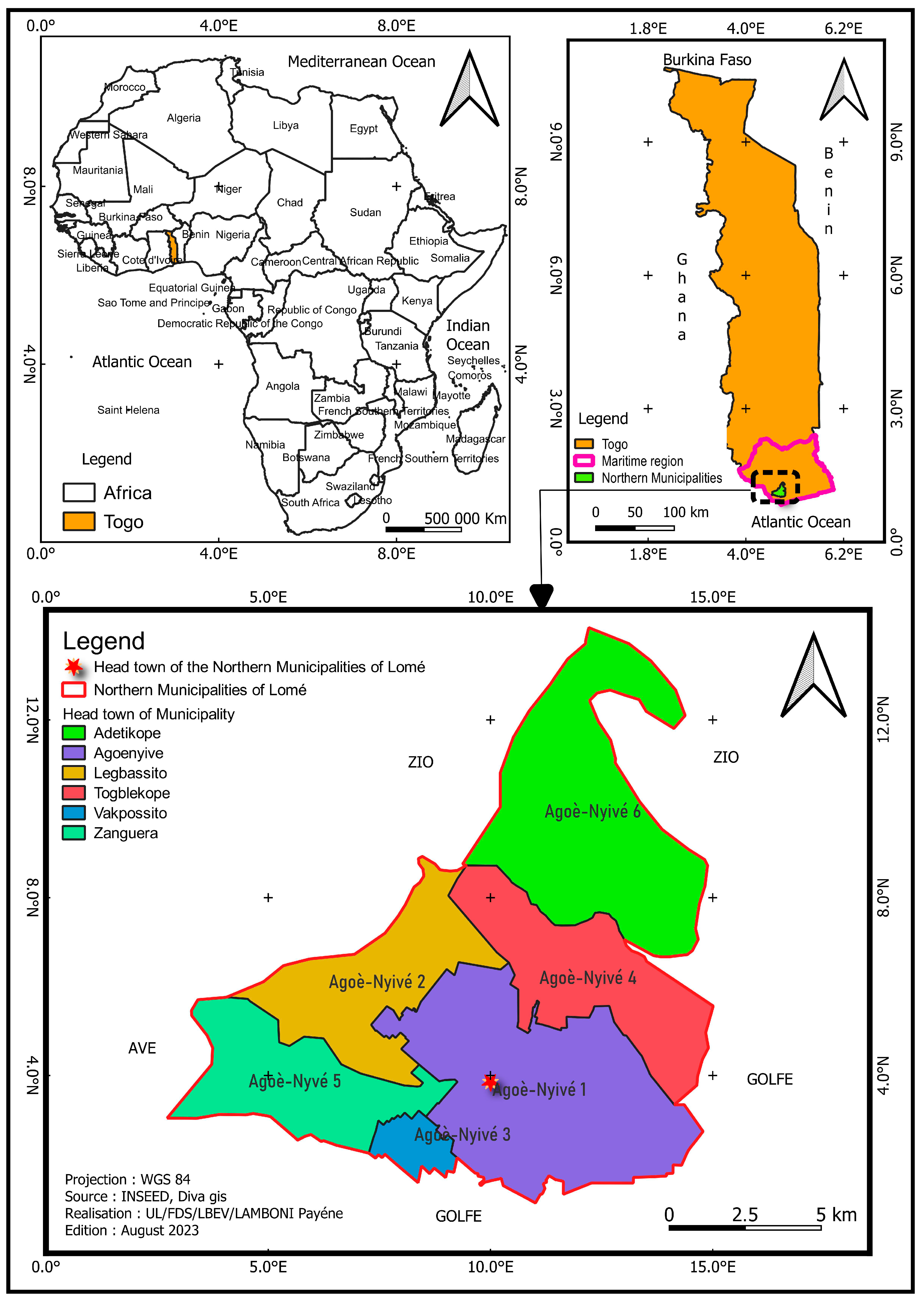
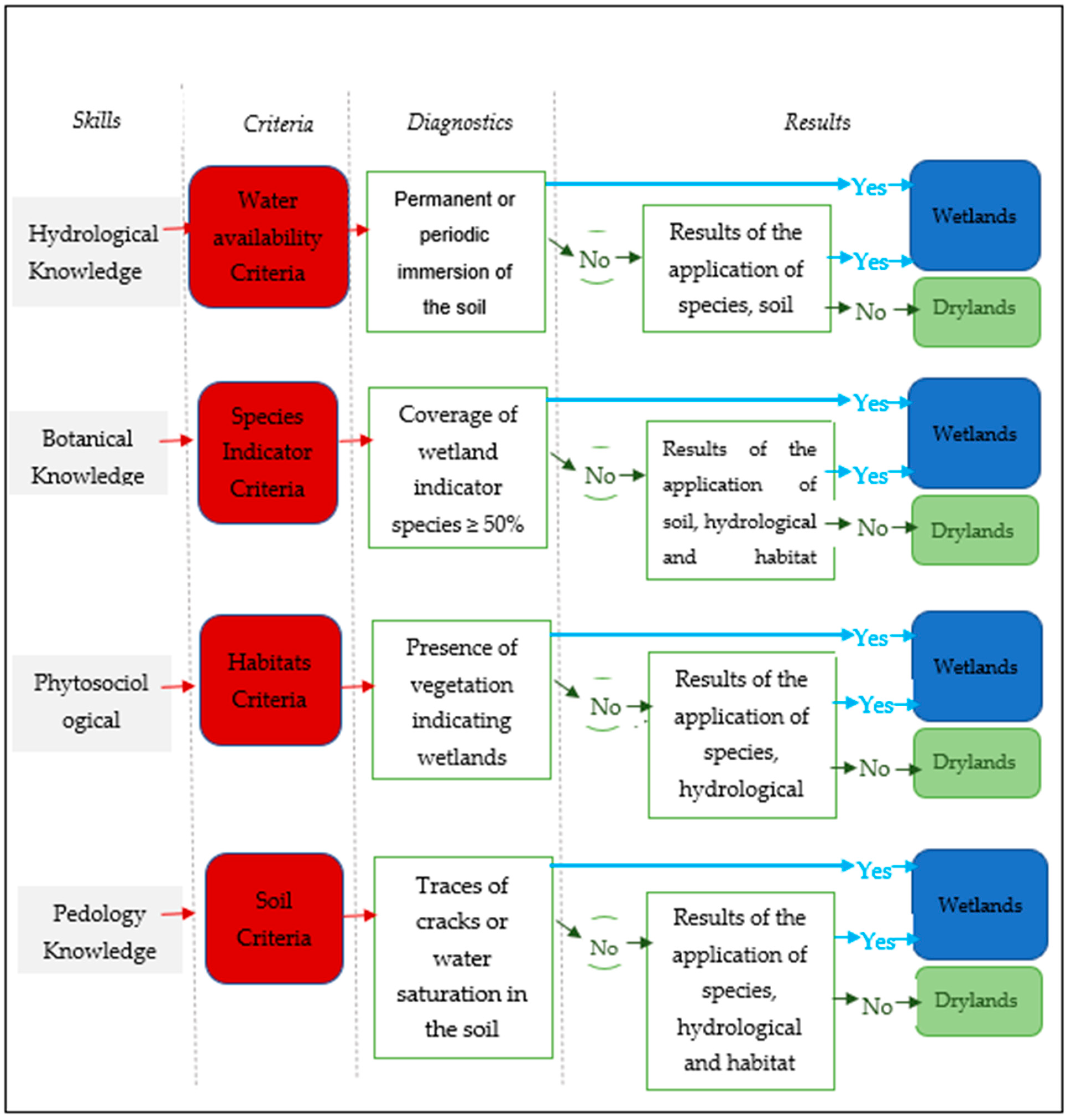


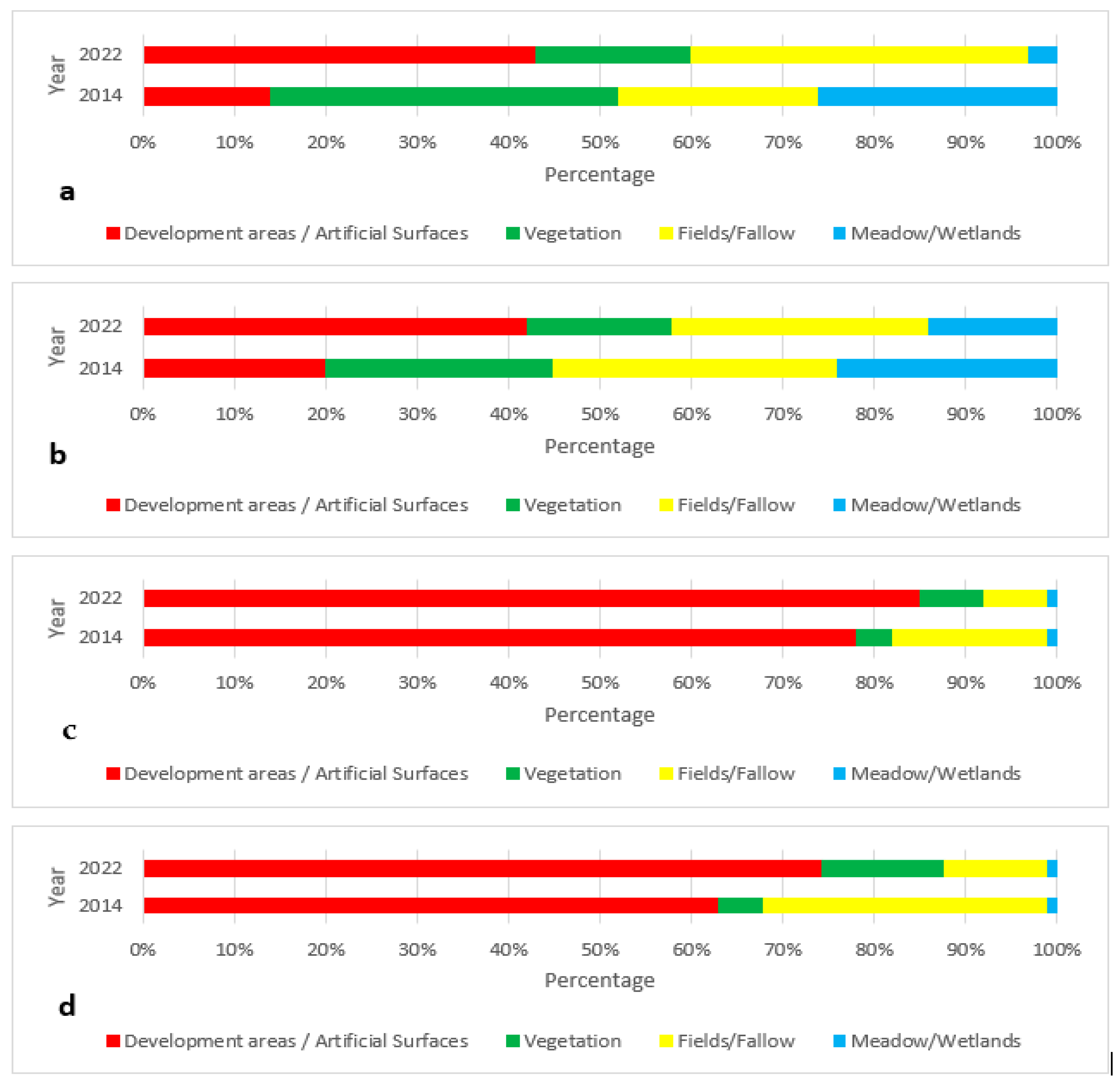
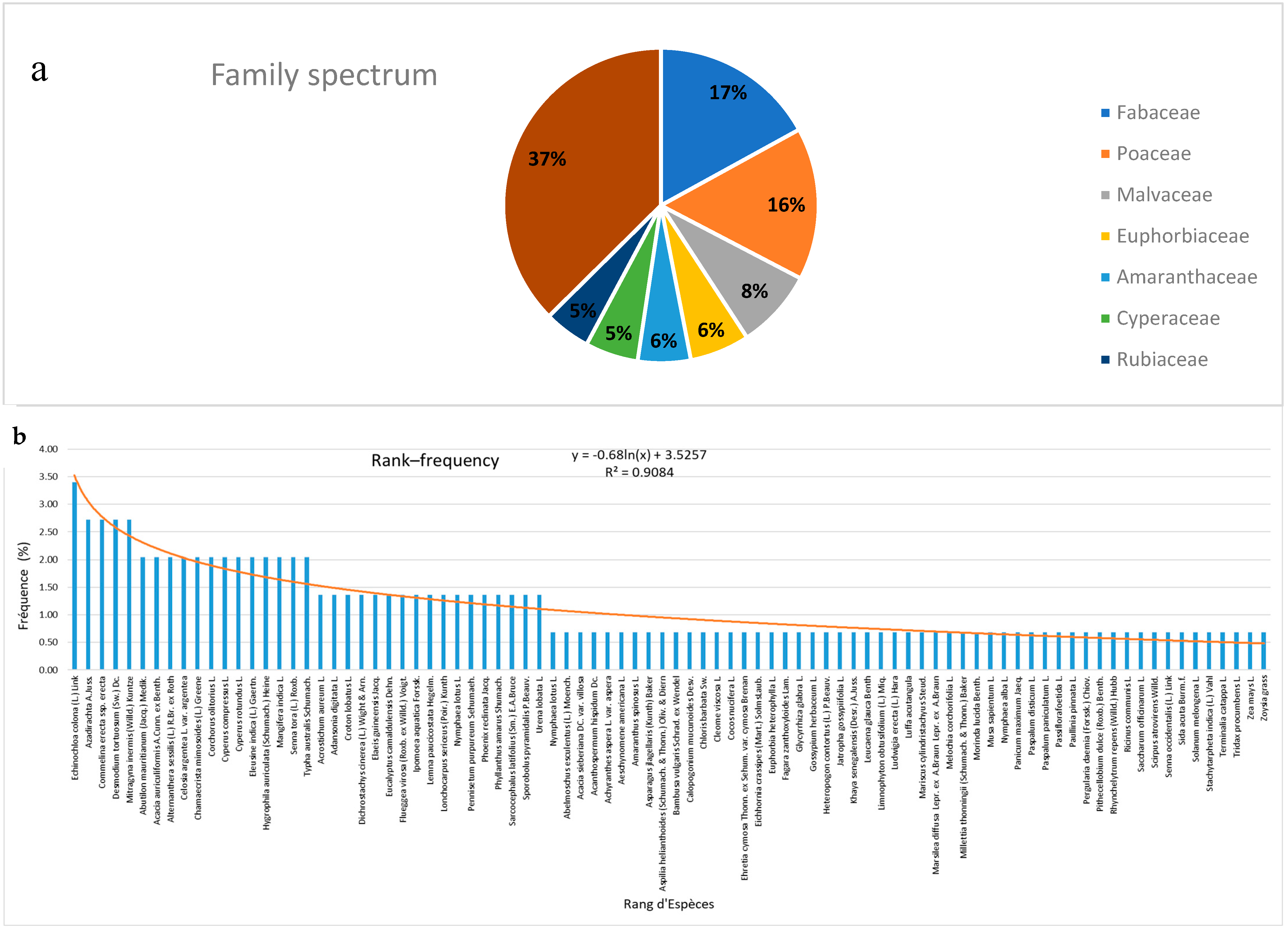
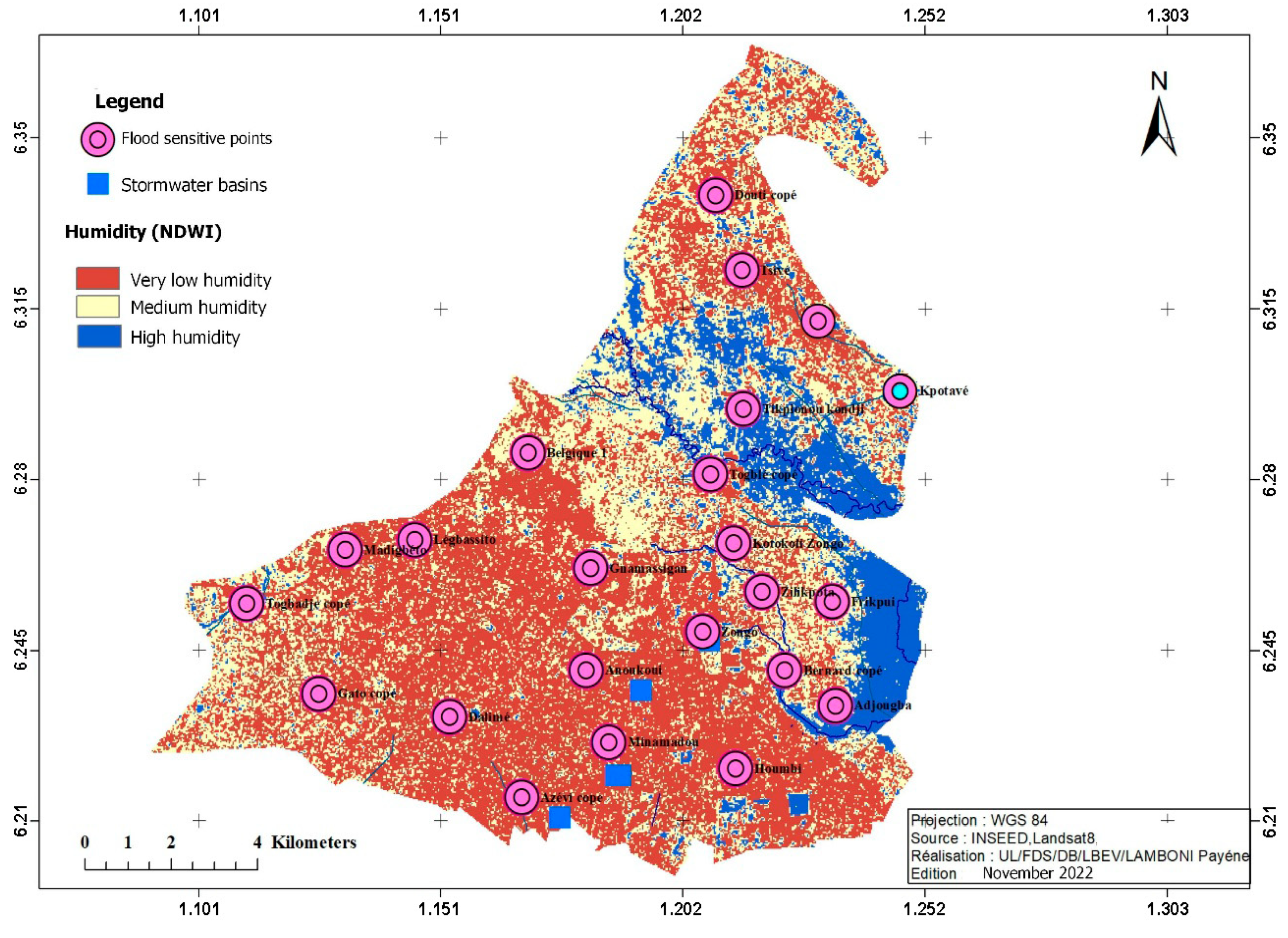



| Wetland Type | Dominant Vegetation Formations | Characteristic Species |
|---|---|---|
| Alluvial plain | Flooded savannah, croplands, and permanent ponds | Mitragyna inermis (Willd.) Kuntze, Sarcocephalus latifolius (Sm.) E.A.Bruce, Dichrostachys cinerea (L.) Wight & Arn, Lonchocarpus sericeus (Poir.) Kunth, Echinochloa colona (L.) Lin |
| Lowland meadows | Hygrophilous and hydrophilous vegetation, and permanent ponds | Typha australis Schumach., Mariscus cylindristachyus Steud., Scirpus atrovirens Willd., Persicaria senegalensis (Meisn.) Sojak, Mitragyna inermis (Willd.) Kuntze, Marsilea diffusa Lepr. ex A.Braun, Ipomoea aquatica Forssk., Hygrophila auriculata (Schumach.) Heine, Cyperus compressus L., Cyperus articulatus L., Cyperus rotundus L., Nymphaea lotus L., Nymphaea alba L., Ludwigia erecta (L.) Hara |
| Stormwater retention ponds | Floating aquatic plant species (often invasive) | Eichhornia crassipes (Mart.) Solms, Lemna paucicostata Hegelm. |
Disclaimer/Publisher’s Note: The statements, opinions and data contained in all publications are solely those of the individual author(s) and contributor(s) and not of MDPI and/or the editor(s). MDPI and/or the editor(s) disclaim responsibility for any injury to people or property resulting from any ideas, methods, instructions or products referred to in the content. |
© 2025 by the authors. Licensee MDPI, Basel, Switzerland. This article is an open access article distributed under the terms and conditions of the Creative Commons Attribution (CC BY) license (https://creativecommons.org/licenses/by/4.0/).
Share and Cite
Payéne, L.; Gnamederama, K.; Fousseni, F.; Madjouma, K.; Pikabe, Y.G.; Graw, V.; Bohnett, E.; Dourma, M.; Kperkouma, W.; Komlan, B. Urbanization Impacts on Wetland Ecosystems in Northern Municipalities of Lomé (Togo): A Study of Flora, Urban Landscape Dynamics and Environmental Risks. Conservation 2025, 5, 28. https://doi.org/10.3390/conservation5030028
Payéne L, Gnamederama K, Fousseni F, Madjouma K, Pikabe YG, Graw V, Bohnett E, Dourma M, Kperkouma W, Komlan B. Urbanization Impacts on Wetland Ecosystems in Northern Municipalities of Lomé (Togo): A Study of Flora, Urban Landscape Dynamics and Environmental Risks. Conservation. 2025; 5(3):28. https://doi.org/10.3390/conservation5030028
Chicago/Turabian StylePayéne, Lamboni, Kalimawou Gnamederama, Folega Fousseni, Kanda Madjouma, Yampoadeb Gountante Pikabe, Valerie Graw, Eve Bohnett, Marra Dourma, Wala Kperkouma, and Batawila Komlan. 2025. "Urbanization Impacts on Wetland Ecosystems in Northern Municipalities of Lomé (Togo): A Study of Flora, Urban Landscape Dynamics and Environmental Risks" Conservation 5, no. 3: 28. https://doi.org/10.3390/conservation5030028
APA StylePayéne, L., Gnamederama, K., Fousseni, F., Madjouma, K., Pikabe, Y. G., Graw, V., Bohnett, E., Dourma, M., Kperkouma, W., & Komlan, B. (2025). Urbanization Impacts on Wetland Ecosystems in Northern Municipalities of Lomé (Togo): A Study of Flora, Urban Landscape Dynamics and Environmental Risks. Conservation, 5(3), 28. https://doi.org/10.3390/conservation5030028








